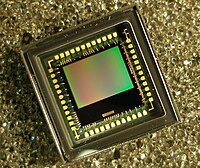Active-pixel sensor

Okay, so imagine you have a camera that takes pictures. To take a picture, the camera needs to have something called an image sensor, which is like the camera's eye. One type of image sensor is called an active-pixel sensor.
An active-pixel sensor is made up of lots of tiny little squares called pixels. Each pixel is like a little bucket that can catch light when you take a picture. When the camera takes the picture, the pixels start to get busy.
Each pixel has a special part called a photodiode, which is a tricky word that means it can turn light into an electrical signal. When light shines on a photodiode, it gets excited and creates a teeny-tiny electrical charge.
Now, each pixel also has a little computer chip that's connected to the photodiode. This computer chip is like the pixel's brain. It's job is to measure how much electrical charge the photodiode is making and turn that into information that the camera can use to make the picture.
So, as you can imagine, the camera's active-pixel sensor is a very busy place. It's got lots of pixels, each with their own photodiode and brain, all working together to take the best picture possible. And that's how an active-pixel sensor works, in a very simplified way!
An active-pixel sensor is made up of lots of tiny little squares called pixels. Each pixel is like a little bucket that can catch light when you take a picture. When the camera takes the picture, the pixels start to get busy.
Each pixel has a special part called a photodiode, which is a tricky word that means it can turn light into an electrical signal. When light shines on a photodiode, it gets excited and creates a teeny-tiny electrical charge.
Now, each pixel also has a little computer chip that's connected to the photodiode. This computer chip is like the pixel's brain. It's job is to measure how much electrical charge the photodiode is making and turn that into information that the camera can use to make the picture.
So, as you can imagine, the camera's active-pixel sensor is a very busy place. It's got lots of pixels, each with their own photodiode and brain, all working together to take the best picture possible. And that's how an active-pixel sensor works, in a very simplified way!
Related topics others have asked about:
